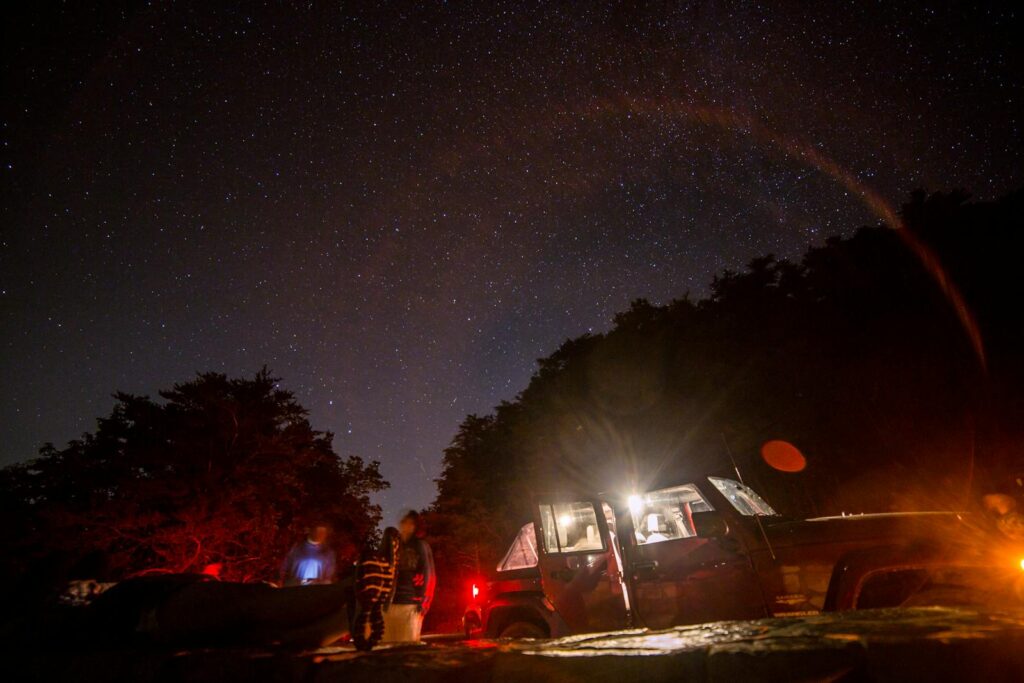Pulling into camp after a long day on the trail is one of the great joys of overlanding. Whether you’re in the deserts of the Southwest, the forests of the Southeast, or exploring abroad, settling into a quiet spot under the stars is what this lifestyle is all about. But once the sun goes down, the world changes. Safety and security at camp—especially at night—should be a top priority for every overland traveler.
From wildlife encounters to theft, storms, or unexpected visitors, nighttime carries unique challenges. With a few good habits, you can sleep easier and keep your rig, your gear, and your crew protected.
Why Camp Security Matters
Camping on public lands or in remote areas is part of the appeal—it offers freedom, solitude, and the chance to connect with nature. But those same freedoms also come with responsibility. Unlike developed campgrounds, there are no rangers checking in, no gates, and no security patrols. You are responsible for your own safety.
Common risks include:
- Wildlife: Bears, coyotes, raccoons, or even curious smaller critters.
- Theft or trespass: Opportunists occasionally pass through remote areas.
- Environmental hazards: Flash floods, falling branches, trip hazards, or high winds.
- Isolation: Help may be miles—or hours—away if something goes wrong.
A Note for Beginners
If you’re new to overlanding or camping in general, consider starting out in managed or park campgrounds. State parks, national parks, and established campgrounds give you a safe environment to learn the flow of camp life at night: cooking, organizing gear, putting out a fire, and hearing the rhythms of the forest. Pull-in RV, tent and primitive sites are a great value and offer a taste of wilderness camping, often with electrical hookups and water on site. (super handy)
Once you’re comfortable with these basics, venturing into dispersed camping and remote public lands will feel more natural and less intimidating. Think of it as “training wheels” for overlanding—valuable experience before you head off the reservation.
Note: Not just for beginners, established campgrounds are a more experienced travelers secret, especially while enroute to an epic backcountry destination. If the journey has transit days where you’re putting in the miles to get somewhere, wild dispersed camping isn’t always the best plan for one-night stays. Take a load off the rig and the mind and enjoy a stay at a state park or commercial campground. You can almost never go wrong. Save the wilderness nights for the destination experience.
General Best Practices for Safety at Camp
1. Choose Campsites Wisely
- Avoid low-lying areas prone to flooding.
- Look up—dead or leaning trees can drop limbs overnight.
- Maintain a balance: not too close to the road, but not so hidden that no one could find you in an emergency.
2. Keep a Clean Camp
- Store food in sealed containers or inside your rig.
- Use odor-proof bags or bear canisters in high-risk areas.
- Pack out all trash and scraps to avoid attracting animals.
3. Manage Fire Responsibly
- Build fires only where allowed.
- Keep water or an extinguisher handy.
- Put it completely out before bed—no glowing embers left behind.
Security Practices for Overland Travelers
1. Lock and Secure Gear
Even remote places see occasional traffic. Keep valuables out of sight and use lockable storage for recovery tools, coolers, and rooftop gear.
2. Light the Perimeter
LED strips, lanterns, or motion-sensor lights discourage unwanted visitors—whether wildlife or strangers.
3. Trust Your Instincts
If a spot feels sketch—move. Sometimes it’s that simple.
4. Keep Essentials Close
Flashlight, first-aid kit, and personal protection (horn, whistle, pepper spray, or local “legal means”) should be within reach on your person, in your tent AND in your locked cab.
// GladiatorUp.com 411: Firearms & Camping
In the United States, many overlanders and campers choose to travel with firearms for personal protection. Before you decide, keep the following in mind:
- Long barrel, break action, single-shot shotguns are generally legal in all 50 states.
- Less-lethal options made by Byrna and others are legal in all 50 states and much of N. America.
- Know the laws: Firearm regulations vary by state and even county. What’s legal in one place may not be in another.
- Respect public lands: National Parks, National Forests, and BLM land each have their own rules. Always check the latest guidance before your trip.
- Safe storage: Firearms should be transported unloaded, securely stored, and inaccessible to unauthorized persons (especially children).
- Training matters: If you choose to carry, complete a certified safety or defensive firearms course.
- Alternatives: Horns, bear spray, and other non-lethal tools can also be effective for camp security.
Disclaimer: This information is for general guidance only and is not legal advice. Always research and follow local laws wherever you travel.
5. Stay Aware
Do a quick perimeter check before dark. Know your surroundings and nearby campers, if any.
Special Considerations for International Travel
Overlanding outside the U.S. opens up incredible opportunities—but also adds layers of complexity.
- Know the laws: Rules for camping, fires, or carrying self-defense items vary widely.
- Language & culture: In some countries, wild camping may be illegal or frowned upon. Managed campgrounds are often the safer, smarter option.
- Travel documents: Keep passports and valuables secure and hidden.
- Local risks: Research common hazards—wildlife, crime, or weather—before you set out.
When in doubt abroad, choose established campgrounds or designated overland-friendly campsites to get a feel for the environment. Once you’re familiar with local conditions, you can gradually branch out into wilder settings.
bottom line
Whether you’re camping in a Tennessee forest, on Utah slickrock, or along a Baja coastline, night brings a different set of challenges to the overland traveler. By covering the basics—choosing safe campsites, locking up gear, lighting the perimeter, and trusting your instincts—you’ll not only protect yourself but also enjoy the peace and freedom that makes overlanding so rewarding.
If you’re just getting started, stick to managed campgrounds first to build your confidence. Once you’ve learned the nighttime rhythms of camp life, you’ll be better prepared to enjoy the solitude of dispersed camping “off the reservation.”
Adventure is about freedom, but safety is what makes freedom possible.
Here’s to the road unpaved! – Doug
[DISPLAY_ULTIMATE_SOCIAL_ICONS]

